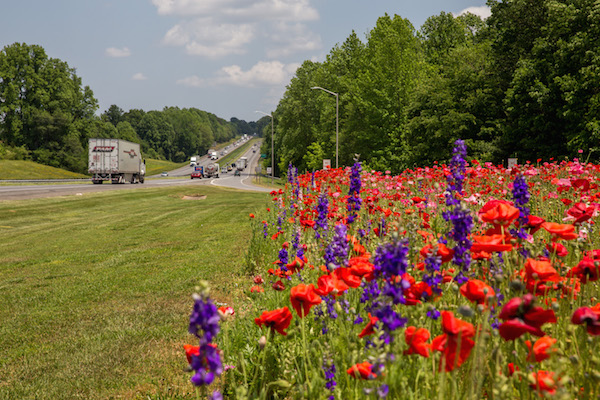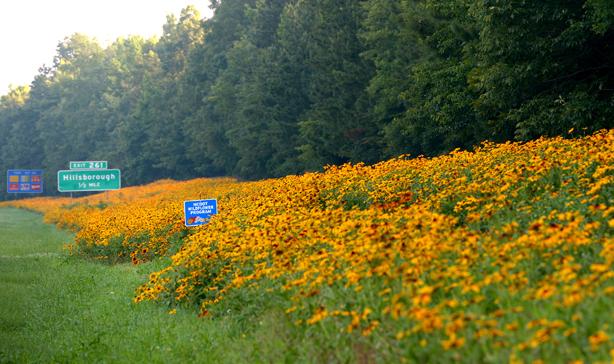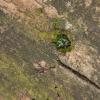This entry originally appeared in the January 2017 Committee on Transportation and Ecology Newsletter.
Speeding down the freeway with the landscape flashing by, thoughts of pollinators may be limited to a brief glimpse of honey bee hives in an orchard, a bright patch of flowers beside the road, or an unfortunate butterfly tossed in the slipstream. Indeed, pollinators and roadsides might seem like an incongruous pairing. After all, roads can fragment habitat, aid in the spread of invasive plant species, and cause animal mortality. But despite the risks associated with roads, roadsides can be a benefit to pollinators.
An immense amount of land is dedicated to roadsides, which form one of the most extensive networks of linear habitats on earth. Roads do cross natural areas, but they also pass through urban areas and intensely farmed landscapes, where they are often the only natural or semi-natural habitat available to pollinators. In the United States, best estimates indicate that federal or state highway agencies manage well over 17 million acres of roadside lands. In addition, national parks and national forests also manage thousands of miles of roadsides. These lands can support a diversity of flowers, may have reduced exposure to pesticides, and have soil which is rarely disturbed—a boon to ground-nesting bees.

From the perspective of a pollinator, roadsides can serve as a place to refuel, to reproduce, and to overwinter. Pollinators might visit roadsides to sip nectar from wildflowers or may be just passing through, using them as corridors between fragments of other habitat. But roadsides can also support entire life cycles of pollinators, from egg to adult. Pollinator communities can be quite diverse on roadsides, and can include bees and butterflies with general habitat needs (bumble bees, for example, which will forage on a range of flowers and nest in old rodent burrows), as well as species with very specific, narrow habitat requirements, such as the Fender’s blue butterfly (lcaricia icarioides fenderi) that has a very limited range and depends upon a single species of lupine for reproduction.
Roadside vegetation management influences how pollinators use roadsides, and even influences the number of pollinators killed by vehicles driving nearby. High quality roadside habitat may reduce the numbers of pollinators killed by vehicles by giving pollinators less need to disperse elsewhere. Researchers in Europe found that the frequency of mowing was linked to the proportion of butterflies killed on roads; butterflies that had to disperse to find new habitat after roadsides were mowed had a greater likelihood of collisions with vehicles. In contrast, roadsides with more species of plants had fewer butterflies killed by traffic.
Not all roadsides are equally valuable habitat for pollinators. Roadsides that are mown frequently, broadly treated with with herbicides, converted to turf grass, or planted with introduced grasses such as brome or fescue, support far fewer pollinators than roadsides with native plants. The use of native plants has additional benefits beyond aesthetics and connections to natural heritage and state identity. Native plants can also serve the functional roles on roadsides that engineers require by providing soil stabilization, reducing weed invasions, and improving water quality by reducing runoff. Additional benefits of native plants include tolerance of drought or heat, trapping snow and preventing it from blowing across roads, and supporting wildlife such as gamebirds and song birds.
But roadsides don’t always need to be completely replanted to benefit pollinators. Sometimes reducing mowing is all that is required to allow existing remnant habitat to flourish. Reducing the intensity of maintenance provides cost savings as well as ecological benefits. An economic study in Florida found that reducing roadside mowing in the state could substantially lower the $13 million spent on mowing each year. Altering mowing regimes can save money and benefit pollinators, without compromising erosion control or motorist safety.

Roadside managers, maintenance staff, and landscape designers can all take steps to improve the quality of roadside vegetation to benefit pollinators, steps that can also reduce costs, maintain public safety, and improve public good will. Working with ICF International, the Xerces Society has produced a series of documents for the Federal Highway Administration (FHWA) that provide practical information on how to plan and implement changes in roadside vegetation management that will benefit pollinators. The documents include background information about the importance of pollinators for people and ecosystems, the importance of roadsides for pollinators, and an overview of how roadside management can support pollinator conservation, as well as best management practices for maintaining and designing roadside vegetation. The documents are based on the latest science as summarized in a literature review of peer-reviewed and technical material and the practical experience of roadside vegetation management practitioners as described through interviews with state departments of transportation and roadside restoration experts. Roadsides have an important place in the conservation of declining wild pollinators and to supporting the health of managed pollinators, and the information provided by FHWA provides a range of options for transportation agencies to consider adopting and integrating into their roadside maintenance and design operations.



